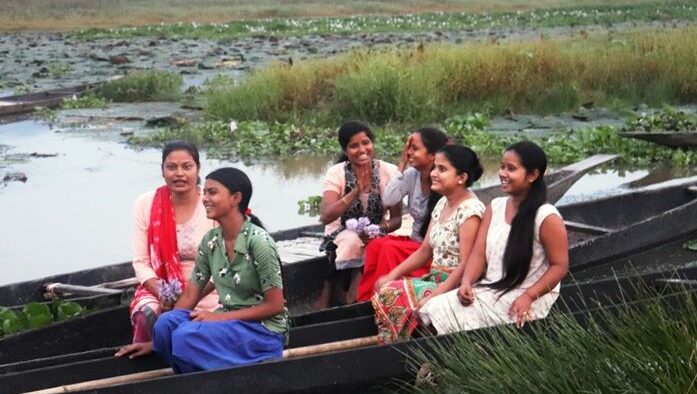Six girls from an indigenous fishing community living in the fringe of the Deepor Beel Wildlife in Assam devised a method to tackle the overgrowth of water hyacinths. Handwoven Moorhen Yoga Mat is an initiative by the Indigenous Fishing Community Using Natural Materials from Deepor Beel Wetland. North East Centre for Technology Application and Reach (NECTAR), an autonomous body under the Department of Science & Technology (DST), of the Indian Government took an innovative initiative to involve the entire women community associated with Simang to create wealth from water hyacinth plants, which are generally considered a nuisance to the ecosystem and waste and therefore unwanted.
The pseudo stem of the water hyacinth is used to make the Moorhen Yoga mat. This initiative of NECTAR will fulfil the dream of the six girls from the fishing community to introduce their unique product to the world market. At the same time it will also create a huge livelihood to the local people, particularly women of that region. Each mat requires approximately 2 kg of water hyacinth which is left after drying 12 kgs of fresh water hyacinth cut and collected from the Beel.
CSP was in conversation with Arun Kumar Sarma, Director General of NECTAR, where he spoke to us at length about the recent innovation using water hyacinths.

Can you tell us about the six girls who are involved in this project and how it has helped the community?
Handwoven Moorhen Yoga Mat, an initiative by the Indigenous Fishing Community Using Natural Materials from Deepor Beel Wetland, for the Conscious Souls. It is initiated by North East Centre for Technology Application and Reach (NECTAR), an autonomous body under DST, Govt. of India.
Simang, meaning ‘dream’, is a collective led by six girls from the fishing community living in the fringe of the Deepor Beel Wildlife Sanctuary, whose families are directly dependent on the wetland for their survival. They have self-trained themselves in fibre processing and making products out of the natural materials like water hyacinth present within their ecosystem. During the pandemic, they shared their learnings through ‘free to all’ training programs with other women in their community, such that their livelihood is made possible for others. Today 38 women from three fringe villages (Keotpara, Notun Basti and Borbori) work with them to produce Yoga Mats using water hyacinths.
What part of the hyacinth is used to make these mats and why?
The pseudo stem part of false stem (Botanically called Leaf petiole) is used to make these mats. These pseudo stems are made of lignins that are the major component of plant fibre. There is no branching of the water hyacinth plant. It’s leaf petiole (leaf base) is elongated and swollen for the air pocket which gives strength to freely float on the water body. The log, spongy character gives a comfort feel, hence it is adopted.
Water hyacinth (Eichhornia Crassipes) is a widely used natural fibre. Earlier studies show that it contains Potassium (K) Carbon (C), Oxygen (O), chlorine (Cl) Magnesium (Mg) and calcium (Ca).(doi.org/10.1080/10667857.2018.1483862). However, it requires further study to know more about its chemical composition.
What is the ecological significance of this project? How does it help the community around?
Water hyacinth enhances water loss by 2.5 to 3 times due to evaporation. Furthermore, there is reduction in biodiversity. Other aquatic plants have difficulty in surviving and the diversity of fish stocks is often affected due to the proliferation of water hyacinth. It also becomes a source of breeding ground for mosquitoes and other parasites.
Its removal helps to conserve water and rejuvenate the environment. Various studies and satellite-based observations have shown the shrinkage of the Beel area over the last three decades, but also the drastic spread of this aquatic weed is not only disrupting the natural ecosystem but also reducing the number of migratory birds visiting the area in the winter season every year.
How do they plan to market it in global markets?
For a systematic approach to promote Moorhen Yoga mat as a sustainable Livelihood option, marketing linkage has to be established and tracking of the growing needs of customers is also to be kept in account. Thus, the following initiatives are to be undertaken in realizing the goals of establishing a sustainable Global Market Linkage – a good harvesting practise, collection centres of water hyacinth and processing units for drying, storing etc.; establishment of Common Facility Centre for weaving and rest work in the villages and make it sustainable in the long run. Preparation of Catalogues, Website and Documentation to be done for product marketing. Organizing local, regional, national level exhibitions to promote the Yoga mats. Tie up with buyers and exporters with large volumes. Tie up with vendors/ shops of nearby areas / locality in reference to Tourist hot spots. Linkage with marketing organizations and online marketing agencies to be developed

Can you describe the traditional Assamese loom and its origin? How does the loom function?
Assam has always had a rich tradition of handloom weaving. Handloom weaving is in fact, the symbol of the largest and oldest cottage industry of Assam and there is hardly any village with no loom. Weaving has been descending from generation to generation through the pathways of centuries of old history. It is known for its rich textures and designs. Handloom weaving is characterized by its distinctiveness and although most of the products are of purely utility purpose some of them are used for certain occasions are of beauty, durable quality, delicate weave, dainty design and delightful colours. The colour and design sense varies from weavers to weavers, tribes to tribes and community to community. The raw materials used in the industry of Assam are mainly Muga or golden silk, paat or mulberry silk, Eri or Endi silk which is also known as Non-violence silk. The traditional handloom products of Assam are Mekhela chaddar, gamocha, dhoti and kurta etc.




